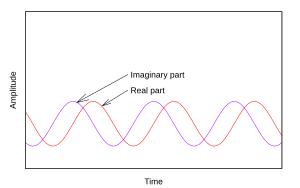Negative frequency
The concept of signed frequency (negative and positive frequency) can indicate both the rate and sense of rotation; in can be as simple as a wheel rotating clockwise or counterclockwise. The rate is expressed in units such as revolutions (a.k.a. cycles) per second (hertz) or radian/second (where 1 cycle corresponds to 2π radians).
Sinusoids
Let ω be a nonnegative angular frequency with units of radians/second. Then the function f(t) = −ωt + θ has slope −ω, which is called a negative frequency. But when the function is used as the argument of a cosine operator, the result is indistinguishable from cos(ωt − θ). Similarly, sin(−ωt + θ) is indistinguishable from sin(ωt − θ + π). Thus any sinusoid can be represented in terms of positive frequencies. The sign of the underlying phase slope is ambiguous.
The ambiguity is resolved when the cosine and sine operators can be observed simultaneously, because cos(ωt + θ) leads sin(ωt + θ) by 1/4 cycle (= π/2 radians) when ω > 0, and lags by 1/4 cycle when ω < 0. Similarly, a vector, (cos ωt, sin ωt), rotates counter-clockwise if ω > 0, and clockwise if ω < 0.
The sign of ω is also preserved in the complex-valued function:
-
(Eq.1)
since R(t) and I(t) can be separately observed and compared. Although clearly contains more information than either of its components, a common interpretation is that it is a simpler function, because it simplifies many important trigonometric calculations, which leads to its formal description as the analytic representation of .[B]
The sum of an analytic representation with its complex conjugate extracts the actual real-valued function they represent. For instance:
-
(Eq.2)
which gives rise to the interpretation that cos(ωt) comprises both positive and negative frequencies. But the sum is actually a cancellation that results in an ambiguity (the sign of ω). Any measure that indicates both frequencies includes a false positive (or alias), because ω can have only one sign.[C] The Fourier transform, for instance, merely tells us that cos(ωt) cross-correlates equally well with cos(ωt) + i sin(ωt) as with cos(ωt) − i sin(ωt).[D] Nevertheless, it is sometimes useful (and mathematically valid) to treat this as the combination of two different (positive and negative) frequencies.
Applications
Simplifying the Fourier transform
Perhaps the most well-known application of negative frequency is the formula:
which is a measure of the energy in function at frequency When evaluated for a continuum of argument the result is called the Fourier transform.[E]
For instance, consider the function:
And:
Infinite duration is a simplification that facilitates this discussion. Looking at the first term above, when the negative frequency cancels the positive frequency, leaving just the constant coefficient (because ), which causes the infinite integral to diverge. At other values of the residual oscillations cause the integral to converge to zero. This idealized Fourier transform is usually written as:
For realistic durations, the divergences and convergences are less extreme, and smaller non-zero convergences (spectral leakage) appear at many other frequencies, but the concept of negative frequency still apples. Fourier's original formulation (the sine transform and the cosine transform) requires an integral for the cosine and another for the sine. And the resultant trigonometric expressions are often less tractable than complex exponential expressions. (see Analytic signal, Euler's formula#Relationship to trigonometry, and Phasor)
Sampling of positive and negative frequencies and aliasing

See also
Notes
- ^ The equivalence is called Euler's formula
- ^ See Euler's formula § Relationship to trigonometry and Phasor § Addition for examples of calculations simplified by the complex representation.
- ^ Conversely, any measure that indicates only one frequency has made an assumption, perhaps based on collateral information.
- ^ cos(ωt) and sin(ωt) are orthogonal functions, so the imaginary parts of both correlations are zero.
- ^ There are several forms of the Fourier transform. This is the non-unitary form in angular frequency of time
Further reading
- Positive and Negative Frequencies
- Lyons, Richard G. (Nov 11, 2010). Chapt 8.4. Understanding Digital Signal Processing (3rd ed.). Prentice Hall. 944 pgs. ISBN 0137027419.











![{\displaystyle {\begin{aligned}{\hat {f}}(\omega )&=\int _{-\infty }^{\infty }[A_{1}e^{i\omega _{1}t}+A_{2}e^{i\omega _{2}t}]e^{-i\omega t}dt\\&=\int _{-\infty }^{\infty }A_{1}e^{i\omega _{1}t}e^{-i\omega t}dt+\int _{-\infty }^{\infty }A_{2}e^{i\omega _{2}t}e^{-i\omega t}dt\\&=\int _{-\infty }^{\infty }A_{1}e^{i(\omega _{1}-\omega )t}dt+\int _{-\infty }^{\infty }A_{2}e^{i(\omega _{2}-\omega )t}dt\end{aligned}}}](https://wikimedia.org/api/rest_v1/media/math/render/svg/0be3c33e876faf0c78dba0e8471b37af2406f1b3)





